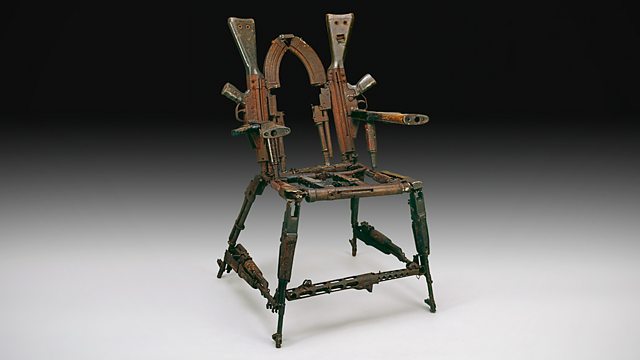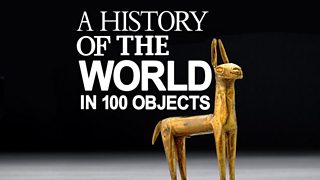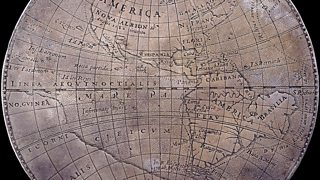Throne of Weapons
Neil MacGregor is exploring the forces that helped create the modern world. Today he is with guns in Africa and a remarkable throne made out of decommissioned weapons.
The history of humanity, as told through one hundred objects from the British Museum in London, is drawing to an end.
Throughout this week, Neil MacGregor, the director of the British Museum in London, has been with things that help explain the modern world. He has explored political and sexual politics and freedoms, and now reflects on the impact of guns and weapons in the modern world - especially in Africa where thousands of children have been participants in brutal conflicts.
He tells the story through a work of art - a sculptured throne made from decommissioned guns like the ubiquitous AK47. We hear from Kester, the artist from Mozambique who created theThrone of Weapons and test the reaction to the piece of Kofi Annan, the former Secretary-General of the United Nations.
Producer: Anthony Denselow
Last on
![]()
Discover more programmes from A History of the World in 100 Objects about art.
About this object
Location: Made in Maputo, Mozambique
Culture: The Modern World
Period: 2001
Material: Metal
��
This sculpture is made out of decommissioned weapons from the Mozambique civil war (1977 - 92), which claimed almost 1 million lives and left 5 million people displaced. It represents both the tragedy of that war and the human triumph of those who achieved a lasting peace. It was made by the Mozambican artist Cristóvão Canhavato (Kester) in 2001 for the Transforming Arms into Tools project, where some of the seven million guns left in the country are voluntarily exchanged for useful tools and hardware.
What caused the Mozambique civil war?
In 1975 Mozambique declared itself a Marxist-Leninist state after achieving independence from Portuguese colonial rule. The new government's pro-communist and anti-apartheid stance threatened the regimes in neighbouring. South Africa and Rhodesia. They funded an opposition group in an attempt to destabilize the country. In turn the Soviet Union supplied Mozambique with economic and military aid. The civil war finally came to an end after the collapse of the Soviet Union and the end of the apartheid regimes.
Did you know?
- The Transforming Arms into Tools project in Mozambique has seen over 600,000 weapons surrendered in exchange for tools.
Art, memorial and celebration
By Chris Spring, curator, British Museum
��
The Throne of Weapons represents both a human tragedy and a human triumph. Its anthropomorphic qualities - it has arms, legs, a back and most importantly a face - actually two faces - link it immediately to the arts of Africa, in which non-figurative objects such as chairs, stools, weapons and pots are seen and described as human beings. Whether we see these faces as crying in pain or laughing with joy at a new peace is in the eye of the beholder.
The Throne is also a contemporary work of art with a global significance, linking the arts of Africa with the Western arts scene, and Mozambique with the global arms trade. None of the guns in the Throne were made in Mozambique, none in Africa, thus it becomes a sculpture in which we are all, one way or another, complicit.
On one of the wooden butts of the AK 47s which make up the arms of the Throne, the artist Kester has begun to sign his name, an accepted tradition among artists in the West, whereas on the other the termites have left their signature as they have on many 'traditional' works of African wood sculpture. On the one hand the Throne is a modern work of art with many international dimensions and layers of meaning; on the other it is closely linked to African wood carving traditions, and in particular to the creation of headrests, stools and thrones which may symbolise the power and prestige of their owners, but also their willingness and ability to talk to their fellow men and to the ancestors.
Mozambique’s national flag shows the AK47 crossed with a hoe above an open book which represents the new constitution achieved after the war of independence ceased in 1975. During the ensuing civil war, feelings towards the AK changed. The book A Different Kind of War Story by the anthropologist Carolyn Nordstrom explores the many different voices of those who were involved in Mozambique’s brutal civil war, allowing them to tell through poetry, prose and pictures the stories of those who were the real heroes as well as the victims of the war. Nordstrom reveals that peace was achieved in the main by people who, though unarmed, were brave enough to reject the culture of violence and the addiction to the gun which had taken hold of the country.
The Throne is a memorial to those people; it is a war memorial, but it celebrates another kind of courage and another kind of victory. Museums are more and more concerned with portraying intangible as well as tangible heritage as a way of building an emotional bridge with a past inhabited by people rather than by the objects they created, especially when charged with describing traumatic histories of warfare, slavery and the abuse of human rights.
The Throne of Weapons allows us to cross that bridge.
Disarming both minds and hands
By Frances Carey, British Museum
��
The Throne of Weapons is perhaps the British Museum’s most eloquent object, certainly the one that has been shown in the greatest variety of contexts: community and shopping centres, cathedrals, popular music concerts, youth forums, government offices and a prison, as well as to museums from south London to Perth in Scotland, Cardiff in Wales and Belfast in Northern Ireland in the UK and exhibition venues internationally.
The components of the Throne of Weapons document Mozambique’s particular past and an international arms trade that continues to reflect competing spheres of political influence. The often visceral reaction to these components is a vivid reminder of how many people have been the victims, witnesses and the perpetrators of violence – directly and indirectly - both locally and globally.
Yet the Throne of Weapons is so much more than the sum of its parts, speaking of the will to overcome violence through practical and creative means which resonates with people at a personal and collective level.
In south London children made their own ‘throne of weapons’ out of toy guns given in exchange for seeds to grow in their gardens or window boxes. In Cardiff a child at one of the schools to which the throne went wrote : ‘Can you hear time burning the hate away?’ The ‘armschair’ from Maputo will have many more calls upon its presence, its power as a work of art and the message that both minds and hands must be disarmed.
‘Now we are free’
By Kester, artist, Throne of Weapons
��
I wasn’t affected directly by the civil war but I have two relatives who lost their legs. One stepped into a minefield and she lost her leg, and the other, a cousin of mine, lost his leg because he was fighting with Frelimo. I also had an aunt who was killed by Renamo. The war was just so horrendous, so difficult; I don’t know how to talk about it.
At the top you can see a smiling face. And there is another smiling face – the other rifle butt. And they are smiling at each other as if to say ‘now we are free’.
There is no conflict between us anymore. I didn’t carve the smile, its part of the rifle butt. The screw holes and the mark left from where the strap was attached to the gun. I wanted to just use the gun as it was, not change it. So I chose the guns and the weapons that had the most expression. Also the back of the chair is curved. You can see a kind of archway or a door of a church. You can imagine you are at the door of a church.
Transcript
Broadcasts
- Wed 20 Oct 2010 09:45�鶹������ҳ��� Radio 4 FM
- Wed 20 Oct 2010 19:45�鶹������ҳ��� Radio 4
- Thu 21 Oct 2010 00:30�鶹������ҳ��� Radio 4
- Wed 17 Nov 2021 13:45�鶹������ҳ��� Radio 4
Featured in...
![]()
War—A History of the World in 100 Objects
A History of the World in 100 Objects - objects related to war.
![]()
Art—A History of the World in 100 Objects
A History of the World in 100 Objects - objects related to Art.
Podcast
-
![]()
A History of the World in 100 Objects
Director of the British Museum, Neil MacGregor, retells humanity's history through objects





